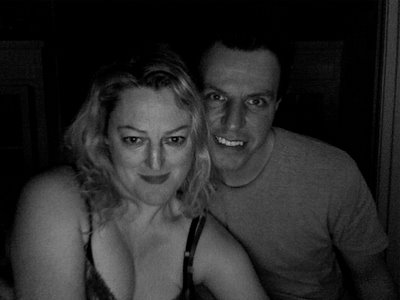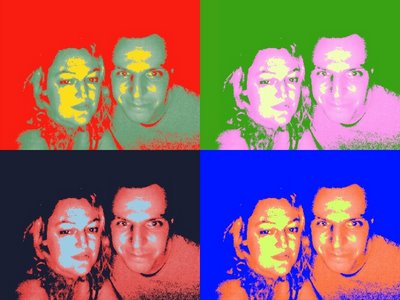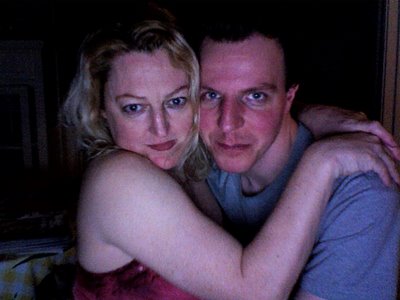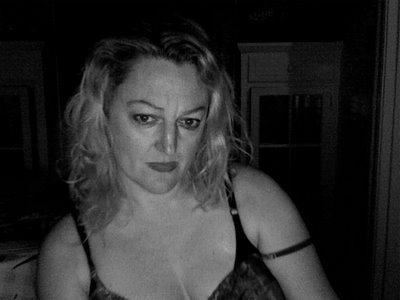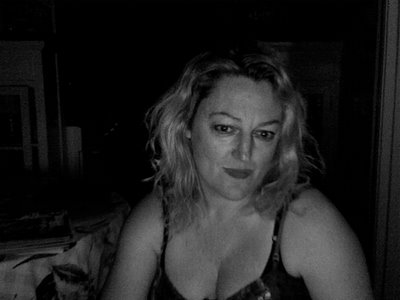A few years ago my family and I stayed with a doctor that said when he was a med student he volunteered to be tested for effects of LSD. I found this so interesting, and especially because this took place in a rural area in Canada. Since then I have been doing a fair bit of reading about the doctors involved in the LSD research in prairie farmland Canada in the 1950's.I remember hearing that if someone was taking psychedelic drugs and wanted to "come down" or sober up to take mega doses of Niacin (part of vitamin B complex). I did not realize that medical response was discovered in Canada and led to understanding the conditions of some mental illnesses.
When ever I meet someone who suffers from depression, or stress I know right away that they have severe vitamin B deficency. A major contributor to our low level malnutrition isn't because we aren't eating enough, it's what we eat. The thing is, almost no one believes this when you tell them. It is impossible to convince most people that their diets and the lifestyle to create these farm diets may actually be the source of their depression and poor physical energy. One fifth of the average diet is from wheat or farm products. Minimum. And these food products are sadly lacking in high nutrition, often the nutritive value has been synthisized and added after processing (cereals, flour, noodles and bread for example all have synthethic iron and vitamin B added. These synthetic vitamins are not as easily absorbed by our system as natural food supplements and food sources.) Even so-called natural or whole grain bread and noodles still offer very few benefits, in fact they leave us hungry and we over eat to compensate for malnutrition, and then often gain weight. Depression may be from our agricultural lifestyle. Is farming the worst mistake in human history? Jared Diamond (author of Guns, Germs and Steel thinks so...he wrote an article that still is compelling in 1987...click here...
Excerpt from an interesting website..."Sometime afterward, I tried niacin to see if it would help my own touch of sleeplessness. I found it worked nicely, and it only took a little to do so, perhaps 100 milligrams at most. Any more and I would experience a warm “flush.” But then I found that when I ate junk food or sugar in quantity, I could hold 500 mg or more without flushing a bit. And when I took all that niacin, instead of flipping out, I was calm. In Vitamin B-3 and Schizophrenia, Dr. Hoffer explains why this is so:
1) As a rule, the more ill you are, the more niacin you can hold without flushing. In other words, if you need it, you physiologically soak up a lot of niacin. Where does it all go? Well, a good bit of it goes into making nicotinamide adenine dinucleotide, or NAD. NAD is just about the most important coenzyme in your body. It is made from niacin, as its name implies.
2) Niacin is also works in your body as an antihistamine. Many persons showing psychotic behavior suffer from cerebral allergies. They need more niacin in order to cope with eating inappropriate foods. They also need to stop eating those inappropriate foods, chief among which are the ones they may crave the most: junk food and sugar.
3) There is a chemical found in quantity in the bodies of schizophrenic persons. It is an indole called adrenochrome. Adrenochrome (which is oxidized adrenalin) has an almost LSD-like effect on the body. That might well explain their behavior. Niacin serves to reduce the body’s production of this toxic material.
How could some of this research apply to learning challenges for children?
Or relieve depressions and stress for adults? Stress, depression and eating habits are also linked to our hormones. Farm foods like bread, wheat, flour, rice, noodles break down very quickly in our stomachs and turns to sugar. These foods turn to sugar much quicker than nutrient rich foods like meat and fiberous vegetables. This warns our hormones that we are in a sugar high and need insulin. So then we are pushing extra insulin into our systems too quickly. Our bodies are being over exposed to hormones. Mood disorders have been associated with several hormone malfunctions including thyroid and diabetic diseases.
Osmond and Hoffer not only worked on LSD but also on niacin, which is now called vitamin B3. It is Bill W. himself who made this term popular, after he realized, thanks to the two researchers, the antipsychotic potential of this vitamin when given in supraphysiologic doses. B3 became known as a treatment for alcoholism, as well as for LSD-induced and schizophrenic psychosis[http://www.doctoryourself.com/hoffer_niacin.html Vitamin B-3: Niacin and Its Amide by A. Hoffer, M.D., Ph.D.]. The underlying adrenochrome and kryptopyrrole (mauve factor) hypotheses were met with stiff, unsubstantiated opposition. The B3 protocol for alcoholism, despite encouraging results, fell into oblivion amongst the Alcoholics Anonymous organization, which gradually became a faith-based organisation reflecting the orientations of the other AA co-founder.
Beyond his interest in drug- and vitamin-assisted therapeutics, Osmond conducted research into the long-term effects of institutionalization, and began a line of research into what he called "socio-architecture" to improve patient settings, coining the terms "sociofugal" and "sociopedal", starting Robert Sommer's career, and making fundamental contributions to environmental psychology almost by accident.
Dr. Osmond died a couple years ago but I think the work he and Dr Hoffer did still offers us much science to reject the farm lifestyle with poor nutritive products and the stress that adds to malnutrition and then mental illness and a lowered quality of life and happiness. Why are we so obsessed with farming? Why do we even believe it is a wonderful romantic occupation? Why do we insist on eating processed farm products like wheat, bread, flour, noodles, sugar and rice? Are we addicted to depression?
Is there another way to make a living?
Check out the terrific blog called How To Save The World sometime. Dave Pollard has all kinds of resources and cool links, this post is just a namesake for his enthusiasm.
Sunday, April 30, 2006
Friday, April 28, 2006
Dinner Downtown
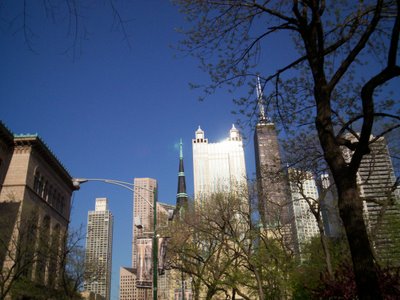
In his book The Naked Artist: Art and Biology, the late British Marxist art critic Peter Fuller described how, in the early eighties he, together with a range of other Marxists, such as Sebastiano Timparo and Raymond Williams, had come to realize that where it concerned fundamental rhythms, shapes, and colors, there can be "no reduction to simple [sic] social and historical circumstances" and that "the material processes of the making of art involve biological processes which can be, and often are, the most powerful elements of the work."[42] excerpt
I participated in a forum with Peter Fuller in the Rivoli bar (Toronto) while he was promoting his incredible book, The Naked Artist years ago. It was a turning point in my youth to adult as an artist. One that a public forum on art be held outside academia and in a bar, a trendy hip urban bar (at the time) and two, his work embraced art as not only natural but intrinisc to being an animal was exhiliarating. He combined the early childhood transitional object (the move from breast to teddy bear, thumb, or blankie study of Winnicott) to art and poetry. He rejected french art theory and philosophy (which was poisoning my university) , his own forays into Marxism, and believed that art was linked to neotony. He was a breath of fresh air from stale dogmas "new philosophy" , and a voice outting the feudal mafia nicknamed "the art world". I've rarely read any art criticism that has even come close to his passion, deduction and insight. He also wrote an strange essay on the concern of America to win a cultural world war after their victory in military dominance. Fuller suggested that the short violent lives and death of most of the Abstract Expressionists was because they knew in their hearts they were being used by the rich elite to claim cultural stature as well as military and financial domination, rather than their art being of value on its own merits. (of course I am paraphrasing, and if an art lover should be reading this I wish you luck at tracing down this book, but it will be worth your while to read almost anything by Fuller)

I love being outside. My dream home is a tepee, which scares the hell out Stagg. So I love to pack food to eat while hanging outside. Made balsamic vinegrette on greens and salmon. I find if I just constantly feed Stagg and he'll hang outside with me. Look at the gallery. Great Warhol show but what is wrong with humans and why can't we make a gallery? We go through all these phases of design, and then reject them and curators and collectors have low self-esteem so they always worry about being historically correct and feel they have to spend millions on renovations. I wonder if this Chicago Museum will do the same. I say, why not have a lottery and draw 50 names of entries and those winners will make art work to hang out side the gallery for one year. Then do it every year. Who cares if they are "historically correct" artists or famous. Or, even more fun, get public volunteers to enter a lottery to pick out 100 entires and judge which ones will decorate the outside of an ugly art gallery building. For that matter why not have a lottery for the public to choose public art. I say, take art history out of the hands of the rich. Lets grow some art consummers. Old galleries had big windows that let fresh air inside. If we can't have fresh air then why not save money to buy more art and forget about renovations, lets let the people decorate the outside of these monoliths with art.

I am always hoping to turn some art lover onto art citic Peter Fuller. I don't think it's easy to find his work, likely out of print. But friends of the late critic maintain a newsletter, Blunt Edge, which seems to emulate his unique approaches to art loving. Here is the introduction to the first issue, 2000.
Blunt Edge is an offspring of the newsletter which has been sent every year to Friends of the Peter Fuller Memorial Foundation. It aims to provide a place for discussion about the visual arts free from the prejudice of current fashion and curatorial justification. The views given here are independent of, and might even be antagonistic to, views held by all or any of the memorial’s trustees.
Any opinion expressed in opposition to the cutting edge inevitably runs the risk of being branded reactionary. Consequently, however uncomfortable, most commentators prefer sitting on the edge to offering serious criticism about it. Writing about the last decade of art in London, Adrian Searle says, ‘We are all probably too close to all of it, and no one wants to be wrong-footed by making definitive judgements.’ Peter Fuller was certainly never slow to make them. Risk is the natural accompaniment to the exercise of discrimination. And as Nicholas Serota has reminded us we took Peter Fuller seriously in spite of his not having ‘an unerring eye.’ But eccentric – occasionally even ridiculous, though they may have been, were Peter’s enthusiasms any less absurd than much of what is offered by Nicholas Serota himself? Most of the conceptual tricks and games played out by today’s favoured artists are second or third hand routines and frequently very heavy-handed ones at that. The sad fact is that most of the new art is not only not new but it is extremely boring. Supposedly challenging and offered with the full authority of adolescent recalcitrance it usually results in bathos. What, for example could be more tedious than a video trip round the inside of Mona Hatoum? For audacity and imagination as well as social comment I would prefer any day to see an episode of South Park.
The best of modernism died with Matisse. And certainly there is no way of putting the clock back. Last year’s words belong to last year’s language… Can the traditional forms of painting and sculpture still extend that tradition? There are few signs that today’s circumstances make that even remotely possible except in occasional isolated cases. If the alternatives to the tradition of ‘art objects’ look pretty threadbare – so unfortunately does the tradition itself. It is time for something really radical and there is no sign of it yet.


From the introduction to Blunt Edge issue#4, 2004.
So what of Elkins’ suggestion that it would be beneficial for historians and critics to do some drawing and painting in order to heal the separation between theory and practice? It has to be asked if there is a disjunction in the first place? Critics and theoreticians are comfortably embedded in ‘the discourse’ – they are integrally part of it. And currently preoccupied as they are with post- Duchampian conceptual approaches to art – even in painting and drawing, it is unlikely that practice would do any more than reinforce the status quo. Matthew Collings is one prominent critic who does make a point of telling us that he has a studio, and that he paints. And coincidence or not, he offers the sharpest instance of critical instability. As Channel 4’s presenter of the annual Turner Prize ceremony he has been closely involved with the BritArt phenomenon. But now, in his disarming way, he lets it be known that in fact he thinks that ‘the whole art scene is made up of a bunch of idiots.’ Through the confusion of his contradictions, Collings is aware that he speaks as the art scene’s Fool, “The mandarin people in charge of the Turner Prize, and the media people at Channel 4, and middle class people who run the art columns on the broadsheets, all assume ordinary people must have this stuff explained to them – but the motivations for doing that are completely bullshit. It’s for commercial reasons, to get the ratings up.” .
Collings anticipates a blight of pseudo art lasting years and years, with the only hope for genuine expression coming from “some sort of cultural underground.” Perhaps that’s all the Fool is destined to do: tell the emperor that he is naked. He need not have solutions but he has to stay on at the court otherwise he loses his role as the royal conscience. It will be interesting to see how often Collings is able to prise himself away from his celebrity connections for some subversive underground work.
The ‘underground’ idea is appealing. It would form outside ‘the discourse’ and would have to avoid art history’s labels – not just “immediately” but altogether. It could pay homage to Schiller and think of itself as ‘The Aesthetic Education of Man’.


Thursday, April 27, 2006
Atelier Gallery Fine Canadian Contemporary Art
My pal John and I were gallery hopping in Vancouver last December and one of the shows we saw was this one. At first I wasn't taken by the small drawings then I did a double take, then fell in love. Morstad also has a childrens book which I would recommend, you can buy through the gallery only $15. You may recognize this artist as one of her pieces is the cover album for Neko Cases awesome record, Fox Confessor Brings The Flood. (kiki and mister anchovy, you should own it)
Wednesday, April 26, 2006
Jane Jacobs, Social Critic Who Redefined and Championed Cities, Is Dead at 89 - New York Times
One of my heroes died today. What a loss for she was an incredible thinker and mentor. I quoted her work so many times in so many circumstances...she was an inspiration on how to live and how to think.
I used her examples of healthy city life even when I raised my daughter: she wasn't allowed to go to shopping malls or play in public parks. Instead she had to play on street corners, this the advice of Jane Jacobs who said, your neighbours and store owners are part of your extended caregivers. We used to live at 414 Jarvis in Boystown Toronto, near Maitland where transvestite hookers worked, and Jane Jacobs words were put into action. I always knew my daughter was safe because all the trannies knew her and her schedule and that I was her parent. The working girls always said hello to her and asked how school was going and monitored her trips to the corner store. I seem to recall Jacobs was against one way streets too...but Toronto is riddled with them and they offer speedways to drivers now.
I worked across the street from Jacobs in the 90's and knew her as a neighbour to say hi and chat with...she never knew what a groupie I really was, I was in such awe of her I could never fess up.
We lost a great mind today.
I used her examples of healthy city life even when I raised my daughter: she wasn't allowed to go to shopping malls or play in public parks. Instead she had to play on street corners, this the advice of Jane Jacobs who said, your neighbours and store owners are part of your extended caregivers. We used to live at 414 Jarvis in Boystown Toronto, near Maitland where transvestite hookers worked, and Jane Jacobs words were put into action. I always knew my daughter was safe because all the trannies knew her and her schedule and that I was her parent. The working girls always said hello to her and asked how school was going and monitored her trips to the corner store. I seem to recall Jacobs was against one way streets too...but Toronto is riddled with them and they offer speedways to drivers now.
I worked across the street from Jacobs in the 90's and knew her as a neighbour to say hi and chat with...she never knew what a groupie I really was, I was in such awe of her I could never fess up.
We lost a great mind today.
Tuesday, April 25, 2006
John Cartan - 20 Strange and Wonderful Books
I love lists. And the list here is one of the most interesting for book lovers. I read a lot and there were a couple here that stumped me and inspired me to look for them.
More search words that brought people to this blog.
implicit uncompleted comedy northrop frye
realhousewives of orange county
school art toronto
home entertainment system
gnostic minx
anderson cooper
jackalupe
lila
ani difranco
kshatriya
blood meridian
tempest shakespeare
american inventor
comedy contains potential tragedy within itself
working images theoretical base archetypal psychology
realhousewives of orange county
school art toronto
home entertainment system
gnostic minx
anderson cooper
jackalupe
lila
ani difranco
kshatriya
blood meridian
tempest shakespeare
american inventor
comedy contains potential tragedy within itself
working images theoretical base archetypal psychology
Monday, April 24, 2006
ADD? Less talk more photos.
Sunday, April 23, 2006
Minx corners bunny

There are rabbits all over the place in Chicago. I was so surprised and I am obsessed with them. I've been known to stay up all night watching and following racoons in Toronto, or waking up at 4 a.m. to watch eagles hunting in kelp beds in British Columbia. Last night we came home and in our courtyard was a mom rabbit and her baby who she was nursing. She trotted off, then we stood there for ages watching the baby and mom. Until Stagg asked "how long do we keep looking?" And I was okay, lets go. But today a neighbour was outside chasing cats away from the baby rabbit when I got back from picking up coffee. I want to save the bunny.

Then this afternoon, as we were going for groceries I found the baby again. And you know, made Stagg run back upstairs to get the camera. I'm so worried about cats and coyotes getting this bunny.




This is my sasquatch bunny photo. I've seena sasquatch as a matter of fact, on the highway between Kitimat and Terrace. They go for soaks in the natural hotsprings.
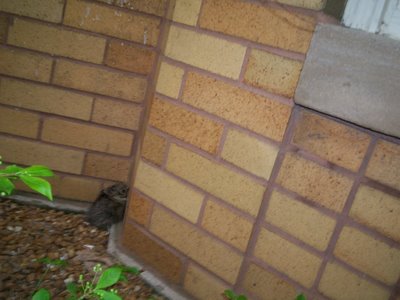
Okay, well I could have not shown this picture, this is where I expose myself as a complete asshole. I feel terrible poor frightened bunny. If the cat wasn't bad enough.

Pilsen
On our way to Pilsen my favourite neighbourhood in Chicago. Behind me is downtown. We are taking some paintings of Staggs for a group show next week and dropping them off. We got a late start today because I got lost looking for an organic grocery store, so we won't make it to the Mexican Cultural Centre this trip.
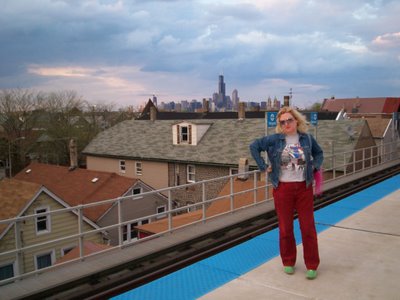
Poem of Quantity
---by Jorge Luis Borges
I think of the stark and puritanical sky
with its remote and solitary stars
which Emerson so many nights would look at
from the snow-bound severity of Concord.
Here, the night sky overflows with stars.
Man is too numerous, Endless generations
of birds and insects, multiplying themselves,
of serpents and the spotted jaguar,
of growing branches, weaving, interweaving,
of grains of sand, of coffee and of leaves
descend on every day and recreate their minuscule and useless labyrinth.
It may be every ant we trample on
is single before God, Who counts on it
for the unfolding of the measured laws
which regulate His curious universe.
The entire system, if it was not so,
would be an error and a weighty chaos.
Mirrors of water, mirrors of ebony,
the all-inventive mirror or our dreams,
lichens, fishes, and the riddled coral,
the clawmarks left by tortoises in time,
the fireflies of a single afternoon,
the dynasties of the Auraucarians,
the delicate shapes of letters in a volume
which night does not blot out, unquestionably
are no less personal and enigmatic
than I, who mix them up. I would not venture
to judge the lepers or Caligula.
Things
The fallen bolume, hidden by the others
from sight in the recesses of the bookshelves,
and which the days and nights muffle over
with slow and noiseless dust. Also the anchor
of Sidon, which the seas surrounding England
press down into its blind and soft abyss,
The mirror which shows nobody’s reflection
after the house has long been left alone.
Fingernail filings which we leave behind
across the long expanse of time and space.
The indecipherable dust, once Shakespeare.
The changing figurations of a cloud.
The momentary but symmetric rose
which once, by chance, took substance in the shrouded
mirrors of a boys kaleidoscope.
The oars of Argus, the original ship.
The sandy footprints which the final wave
as though asleep erases from the beach.
The colours of a Turner when the lights
are turned out in the narrow gallery
and not a footstep sounds in the deep night.
The other side of the dreary map of the world.
The tenuous spiderweb in the pyramid.
The sightless stone and the inquiring hand.
The dream I had in the approaching dawn
and later lost in the claring of the day.
The ending and beginning of the epic
of Finsburh, today a few sparse verse
of iron, unwasted by the centuries.
The mirrored letter on the blotting paper.
The turtle in the bottom of the cistern.
And that which cannot be. The other horn
Of the unicorn. The Being, Three in One.
The triangular disk. The imperceptible moment
in which the Eleatic arrow,
motionless in the air, reaches the mark.
The violet pressed between the leaves of Becquer.
The pendulum which time has stayed in place.
The weapon Odin buried in the tree.
The volume with its pages still unslit.
The echo of the hoofbeats at the charge
of Junin, which in some enduring mode
never has ceased, is part of the webbed scheme.
The shadow of Sarmiento on the sidewalks.
The voice heard by the shepherd on the mountain.
The skeleton bleaching white in the desert.
The bullet which shot dead Francisco Borges.
The other side of the tapestry. The things
which no one sees, except for Berkeley’s God.

Behind Stagg you can see a church spire and we are heading a few blocks past it tonight.
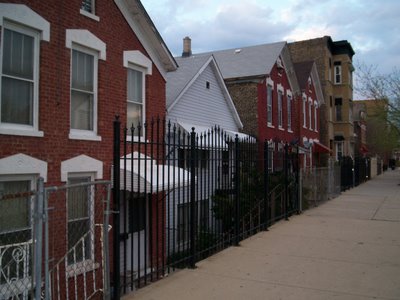

Same church below, up close.
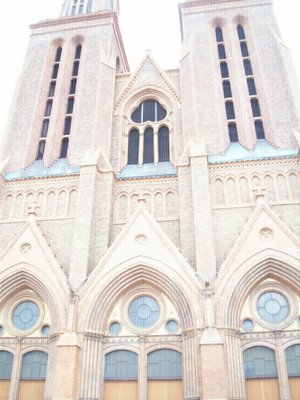
No matter how many times and angles I took a picture of this church, up close, it always came out like this, like talk about illumination...


House of Payne hanging out before a group show. The painting is by Marty, one of Stagg's good friends.
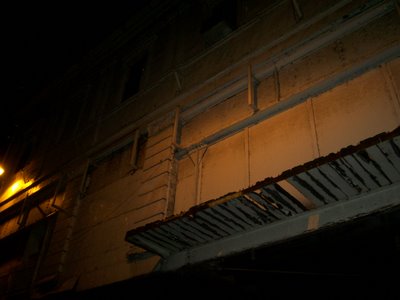
Looking up at the outside of The Loop train platform structure. We are on our way for drinks downtown.

Poem of Quantity
---by Jorge Luis Borges
I think of the stark and puritanical sky
with its remote and solitary stars
which Emerson so many nights would look at
from the snow-bound severity of Concord.
Here, the night sky overflows with stars.
Man is too numerous, Endless generations
of birds and insects, multiplying themselves,
of serpents and the spotted jaguar,
of growing branches, weaving, interweaving,
of grains of sand, of coffee and of leaves
descend on every day and recreate their minuscule and useless labyrinth.
It may be every ant we trample on
is single before God, Who counts on it
for the unfolding of the measured laws
which regulate His curious universe.
The entire system, if it was not so,
would be an error and a weighty chaos.
Mirrors of water, mirrors of ebony,
the all-inventive mirror or our dreams,
lichens, fishes, and the riddled coral,
the clawmarks left by tortoises in time,
the fireflies of a single afternoon,
the dynasties of the Auraucarians,
the delicate shapes of letters in a volume
which night does not blot out, unquestionably
are no less personal and enigmatic
than I, who mix them up. I would not venture
to judge the lepers or Caligula.
Things
The fallen bolume, hidden by the others
from sight in the recesses of the bookshelves,
and which the days and nights muffle over
with slow and noiseless dust. Also the anchor
of Sidon, which the seas surrounding England
press down into its blind and soft abyss,
The mirror which shows nobody’s reflection
after the house has long been left alone.
Fingernail filings which we leave behind
across the long expanse of time and space.
The indecipherable dust, once Shakespeare.
The changing figurations of a cloud.
The momentary but symmetric rose
which once, by chance, took substance in the shrouded
mirrors of a boys kaleidoscope.
The oars of Argus,
The sandy footprints which the final wave
as though asleep erases from the beach.
The colours of a Turner when the lights
are turned out in the narrow gallery
and not a footstep sounds in the deep night.
The other side of the dreary map of the world.
The tenuous spiderweb in the pyramid.
The sightless stone and the inquiring hand.
The dream I had in the approaching dawn
and later lost in the claring of the day.
The ending and beginning of the epic
of Finsburh, today a few sparse verse
of iron, unwasted by the centuries.
The mirrored letter on the blotting paper.
The turtle in the bottom of the cistern.
And that which cannot be. The other horn
Of the unicorn. The Being, Three in One.
The triangular disk.
in which the Eleatic arrow,
motionless in the air, reaches the mark.
The violet pressed between the leaves of Becquer.
The pendulum which time has stayed in place.
The weapon Odin buried in the tree.
The volume with its pages still unslit.
The echo of the hoofbeats at the charge
of Junin, which in some enduring mode
never has ceased, is part of the webbed scheme.
The shadow of Sarmiento on the sidewalks.
The voice heard by the shepherd on the mountain.
The skeleton bleaching white in the desert.
The bullet which shot dead Francisco Borges.
The other side of the tapestry. The things
which no one sees, except for Berkeley’s God.

Behind Stagg you can see a church spire and we are heading a few blocks past it tonight.


Same church below, up close.

No matter how many times and angles I took a picture of this church, up close, it always came out like this, like talk about illumination...


House of Payne hanging out before a group show. The painting is by Marty, one of Stagg's good friends.

Looking up at the outside of The Loop train platform structure. We are on our way for drinks downtown.
Friday, April 21, 2006
Art is buried
The humanities are ruined, and the universities full of crooks. Art in America is neglected, coddled, and buried under chatter. The right looks down on artists; the left looks down on everyone. Our man in Boston has an electrifying conversation with Camille Paglia.
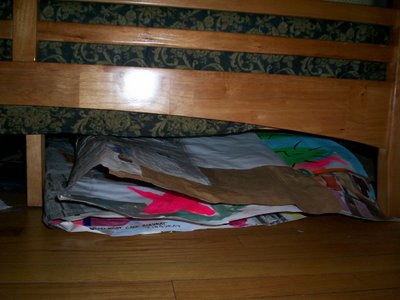
Art in America is also buried under our bed. It may be true that the "right" looks down on artists, but they are major art collectors of Thomas Kinkade. The "left" doesn't seem to collect art except in (YAWN) government galleries. The photos in this post are just a few stored art works Stagg and I have done in the past two weeks.

The above link is a really long interview but it has so much in it about working class, philosophy, passion, and wisdom. Paglia is one of the few intellectuals who is free-thinking and not working for corporations selling cars, like one of her peers. Paglia wants to sell art and poetry: spiritual stuff.


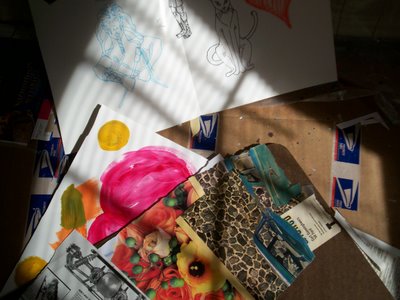

CP: Look, money, what money? What money do you need? The point is I am saying the selection of material at the primary school level needs to be far upgraded. People say, “Ooh we have an art program.” I say, “What do you mean by art program?” Even if it’s available—now in many places it’s not available—they mean sending kids into a room with paints and pencils. That’s not my idea of an art program. My idea is to expose them to art history. At an early age. So they have something in their minds, images that counterbalance the images that are coming at them from ads and special effects. The special effects have gotten out of control—computerized special effects. Now you have movies that are nothing but special effects, overwhelming sound, which is a great sensation, but character acting and script development, social realism—these things are actually declining. So I am very concerned about the cultural future of the United States in this kind of environment. Most people who are secular humanists having the idea that they are doing fine. We are doing fine and our only enemy is the Bible-based far right. The reason why the real threat is the far right is that they have the Bible. And the Bible is a masterpiece. The Bible is one of the greatest works produced in the world. The people who all they have is the Bible actually are set up for life. Not only do they have a spiritual vision given to them but artistic fulfillment. They don’t even recognize just the pleasure of dealing with this epic poetry and drama. Everything is in the Bible. What does the left have? The left has a lot of attitude.
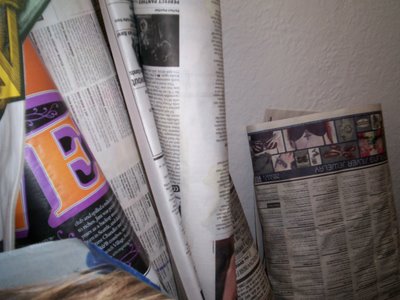
If art is buried with what did we pay for the funeral? Resurrection anybody?
Subscribe to:
Posts (Atom)













